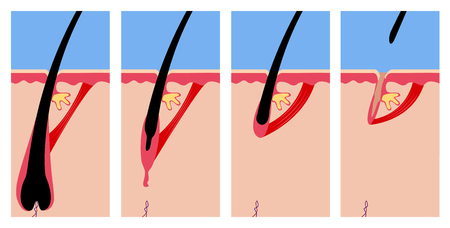Understanding Skin Pigmentation
Skin pigmentation is a fascinating and complex biological process, fundamentally shaped by genetics and environmental factors. At its core, pigmentation refers to the natural colouring of the skin, primarily determined by the presence of melanin—a pigment produced by specialised cells known as melanocytes. The amount and type of melanin synthesised in these cells not only dictate one’s skin tone but also play a critical role in protecting against ultraviolet (UV) radiation.
Melanin exists in two main forms: eumelanin, which imparts brown to black hues, and pheomelanin, responsible for yellow to red tones. The balance between these types varies among individuals and ethnic groups, underpinning the diversity of human skin colour. In the UK, where the climate is often overcast with intermittent sunshine, environmental influences such as reduced UV exposure can affect melanin production and distribution. This is particularly significant given the country’s varied population demographics.
The body’s regulation of pigmentation involves intricate signalling pathways that control melanocyte activity. Genetic factors inherited from our parents largely determine baseline skin tone, while environmental factors—like sun exposure typical during rare British heatwaves—can trigger increased melanin synthesis as a protective response. Understanding these mechanisms is essential for appreciating how skin tone influences health risks, especially in relation to UV damage and related conditions prevalent in the UK.
Genetic Factors in Skin Tone
Skin tone is a highly visible trait shaped primarily by genetics, with inheritance patterns and gene variants influencing the diverse complexions seen across the UK. The primary determinant of skin pigmentation is melanin, produced by specialised cells called melanocytes. Genes such as MC1R, SLC24A5, and OCA2 play significant roles in regulating melanin production and distribution.
The Role of Inheritance in Pigmentation
Each individual inherits two sets of genes, one from each parent, which combine to dictate their unique skin colour. Variations in these genes result in a spectrum of pigmentation, ranging from very fair to deeply pigmented skin tones. Recent UK-based genetic studies—such as those conducted by the University of Edinburgh and UCL—have highlighted how Britain’s multicultural heritage has led to a remarkable range of genetic diversity within the population.
Key Genes Associated with Skin Tone
| Gene | Function | Prevalence in British Populations |
|---|---|---|
| MC1R | Affects red hair and fair skin; increases sensitivity to UV exposure | Common among people with Celtic ancestry |
| SLC24A5 | Major contributor to lighter skin tones in European populations | Widely present across British and European ancestries |
| OCA2 | Influences melanin synthesis; associated with eye and skin colour variation | Diverse variations due to mixed heritage in the UK |
Diversity Across British Communities
The UK’s unique demographic landscape has resulted in a blend of genetic traits that influence pigmentation. For example, individuals with South Asian, Afro-Caribbean, or Middle Eastern ancestry may carry different gene variants compared to those with predominantly Northern European backgrounds. This genetic mosaic not only shapes visual diversity but also impacts susceptibility to pigmentation disorders and sun-related risks.

3. Pigmentation and Its Impact on Health
Skin pigmentation plays a pivotal role in determining an individual’s susceptibility to various dermatological conditions. Melanin, the pigment responsible for skin colour, offers a natural barrier against ultraviolet (UV) radiation. However, the degree of protection varies significantly across different skin tones, influencing health outcomes in tangible ways.
Sunburn Risk and Skin Tone
Fair-skinned individuals, who possess lower levels of melanin, are more prone to sunburn due to increased UV sensitivity. In the UK, approximately 50% of adults report experiencing sunburn at least once per year, with the highest prevalence among those with lighter skin types (Fitzpatrick Skin Types I and II). This heightened vulnerability not only causes discomfort but also elevates the risk of DNA damage within skin cells—a precursor to long-term health issues.
Hyperpigmentation Trends
Darker skin tones, while naturally better shielded from UV-induced sunburn, are more susceptible to hyperpigmentation disorders such as melasma or post-inflammatory hyperpigmentation. Recent NHS data suggests that over 30% of dermatology consultations in multicultural urban centres like London relate to concerns about uneven skin tone or dark spots. These conditions can have significant psychosocial impacts and often require targeted interventions tailored to diverse ethnic backgrounds.
Skin Cancer Incidence Across Pigmentation Spectrum
Melanin’s protective properties do reduce the risk of certain types of skin cancer, particularly melanoma, in individuals with darker complexions. Nevertheless, it is crucial to note that when skin cancer does occur in these groups, it is frequently diagnosed at a later stage—leading to poorer outcomes. According to Cancer Research UK, over 16,000 new cases of melanoma are diagnosed annually, with incidence rates highest among fair-skinned populations. However, awareness campaigns increasingly highlight that no group is immune; regular self-examinations and timely medical advice remain essential for everyone regardless of skin tone.
Emerging Health Trends in the UK
The growing multicultural demographic in Britain underscores the need for nuanced public health messaging around sun safety and pigmentation-related risks. Personalised skincare advice and community-driven education initiatives are gaining traction as strategies to bridge knowledge gaps and promote early intervention. As genetic research continues to elucidate the interplay between pigmentation and health risks, tailored recommendations will become even more central to effective dermatological care across the UK.
4. Societal Perceptions and Cultural Context
The relationship between skin pigmentation and social attitudes in the UK is deeply rooted in both historical and contemporary contexts. The science of pigmentation not only shapes our physical health but also intersects significantly with social identity, self-esteem, and cultural belonging.
Historical Perspectives on Skin Tone in the UK
Historically, perceptions of skin tone in Britain have been influenced by colonial legacies, migration patterns, and class structures. During the era of the British Empire, lighter skin was often associated with privilege and higher social status, while darker skin tones were subjected to systemic discrimination. These historical biases have left a lingering impact on social interactions and opportunities for individuals of various ethnic backgrounds.
Table 1: Historical Attitudes Towards Skin Tone
| Period | Dominant Perception | Societal Impact |
|---|---|---|
| Victorian Era | Lighter skin linked to nobility and purity | Social mobility tied to appearance; darker-skinned individuals marginalised |
| Post-War Britain (1940s-1960s) | Increased visibility of ethnic minorities; ongoing bias | Migrants faced discrimination in housing, employment, and public life |
| Modern Day (21st Century) | Diverse perspectives; growing awareness of inclusivity | Progress towards equality, though colourism persists in subtle forms |
Contemporary Views and Psychological Implications
Today, the UK is home to a rich tapestry of cultures, yet the remnants of historic attitudes can still affect people’s experiences. Social perceptions related to skin tone may influence mental health, confidence, and access to healthcare. Research suggests that individuals with darker pigmentation are sometimes subject to implicit bias within medical settings, potentially impacting the quality of care they receive.
The Influence of Media and Pop Culture
The portrayal of skin tones in British media has gradually evolved. While there is a growing emphasis on representation and diversity, challenges remain regarding stereotypical depictions and underrepresentation of certain groups. This shift in media narratives plays a crucial role in shaping societal norms about beauty and acceptance.
Cultural Movements and Changing Narratives
Grassroots campaigns and community-led initiatives are challenging outdated notions about pigmentation. Organisations across the UK are actively promoting education around the science of skin tone, advocating for equality in healthcare access, and encouraging greater self-acceptance regardless of genetic background.
5. Practical Implications: Risk Reduction and Protection
Understanding the science of pigmentation and its genetic underpinnings is essential for developing practical strategies to reduce skin health risks. Scientific research has shown that while individuals with darker skin tones possess greater natural protection against UV radiation due to higher melanin levels, they are not immune to sun damage or related conditions such as hyperpigmentation and certain skin cancers. Conversely, lighter-skinned individuals in the UK face a higher risk of sunburn and photoageing, especially during prolonged outdoor activities or unexpected sunny spells.
Sun Care Strategies Tailored to Skin Tones
For all skin types, broad-spectrum sunscreen with at least SPF 30 is recommended by dermatologists across the UK. However, those with fairer complexions should be particularly vigilant, reapplying sunscreen every two hours when outdoors and wearing wide-brimmed hats or seeking shade during peak sunlight hours (11am–3pm). Darker-skinned individuals may experience delayed onset of visible sun damage, but scientific evidence suggests they should still use daily sun protection to prevent cumulative cellular damage and uneven pigmentation.
Routine Adaptations for the UK Climate
The British climate often features overcast skies, which can mislead residents into underestimating UV exposure. Studies confirm that up to 80% of UV rays penetrate cloud cover. Therefore, a year-round approach to sun care is advisable regardless of weather or season. Incorporate antioxidant-rich moisturisers and gentle cleansers into your routine to support the skin’s barrier function and counteract environmental stressors typical in urban UK environments.
Addressing Diverse Needs Through Evidence-Based Advice
Genetics play a significant role in an individual’s susceptibility to pigmentary disorders and UV-induced skin changes. Those with a family history of melanoma or pigmentary anomalies should consult with NHS dermatology services for regular skin assessments. Regular self-examinations, awareness of new moles or changing lesions, and prompt professional evaluation remain best practice for all ethnicities. By combining genetic insight with tailored protection strategies, residents across the UK can better safeguard their skin health amidst varying environmental challenges.
6. The Future of Pigmentation Research in the UK
The landscape of pigmentation research is rapidly evolving, with the United Kingdom emerging as a key player in pioneering studies that address both the scientific and societal aspects of skin tone diversity. As the British public becomes increasingly aware of how genetics influence pigmentation and associated health risks, cutting-edge research is moving towards more personalised and inclusive approaches.
Genomics and Personalised Dermatology
Advanced genomic technologies are at the forefront of this shift. UK-based initiatives, such as the 100,000 Genomes Project, are providing unprecedented insights into the genetic variations underpinning skin pigmentation across diverse populations. These findings are set to revolutionise dermatology, enabling more tailored risk assessments for conditions like melanoma and hyperpigmentation, particularly for those with traditionally underrepresented skin tones.
AI-Driven Diagnostics and Preventative Care
The integration of artificial intelligence into clinical practice is another trend gaining traction across NHS trusts and private clinics alike. Machine learning algorithms trained on diverse datasets are helping to identify subtle pigmentation changes earlier and with greater accuracy. This has significant implications for early intervention strategies, especially within multicultural communities throughout the UK.
Socio-Cultural Considerations in Pigmentation Research
British researchers are also placing greater emphasis on the cultural context of pigmentation. Collaborative studies involving community groups aim to address disparities in awareness, access to care, and representation in clinical trials. These efforts not only enhance scientific understanding but also ensure that future treatments are equitable and culturally sensitive.
Looking Ahead: What It Means for the British Public
As these innovations continue to unfold, the British public can expect a future where skin health recommendations are more accurately tailored to individual genetic profiles. Public health campaigns are likely to become more nuanced, reflecting the UKs rich tapestry of skin tones and backgrounds. Ultimately, ongoing investment in pigmentation science promises improved prevention, diagnosis, and treatment outcomes—empowering everyone across Britain to better understand and manage their unique risk factors.


